Correlation Coefficients >
Kendall’s Tau (Kendall Rank Correlation Coefficient)
What is Kendall’s Tau?
Kendall’s Tau is a non-parametric measure of relationships between columns of ranked data. The Tau correlation coefficient returns a value of 0 to 1, where:
- 0 is no relationship,
- 1 is a perfect relationship.
A quirk of this test is that it can also produce negative values (i.e. from -1 to 0). Unlike a linear graph, a negative relationship doesn’t mean much with ranked columns (other than you perhaps switched the columns around), so just remove the negative sign when you’re interpreting Tau.
Several version’s of Tau exist.
- Tau-A and Tau-B are usually used for square tables (with equal columns and rows). Tau-B will adjust for tied ranks.
- Tau-C is usually used for rectangular tables. For square tables, Tau-B and Tau-C are essentially the same.
Most statistical packages have Tau-B built in, but you can use the following formula to calculate it by hand:
Kendall’s Tau = (C – D / C + D)
Where C is the number of concordant pairs and D is the number of discordant pairs.
Example Problem
Sample Question: Two interviewers ranked 12 candidates (A through L) for a position. The results from most preferred to least preferred are:
- Interviewer 1: ABCDEFGHIJKL.
- Interviewer 2: ABDCFEHGJILK.
Calculate the Kendall Tau correlation.
Step 1: Make a table of rankings. The first column, “Candidate” is optional and for reference only. The rankings for Interviewer 1 should be in ascending order (from least to greatest).
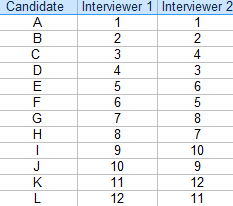
Step 2: Count the number of concordant pairs, using the second column. Concordant pairs are how many larger ranks are below a certain rank. For example, the first rank in the second interviewer’s column is a “1”, so all 11 ranks below it are larger.
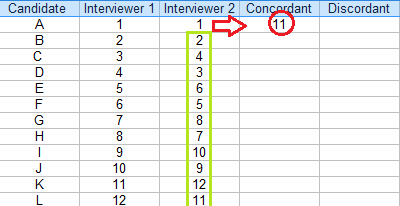
However, going down the list to the third row (a rank of 4), the rank immediately below (3) is smaller, so it doesn’t count for a concordant pair.
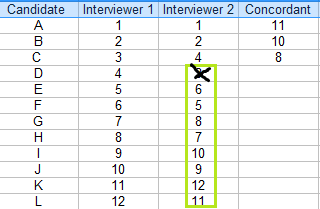
When all concordant pairs have been counted, it looks like this:
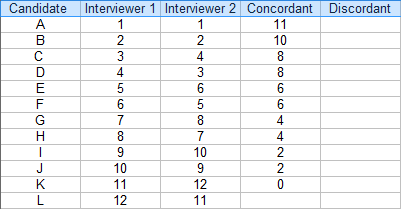
Step 3: Count the number of discordant pairs and insert them into the next column. The number of discordant pairs is similar to Step 2, only you’re looking for smaller ranks, not larger ones.
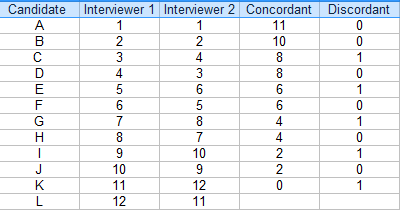
Step 4: Sum the values in the two columns:
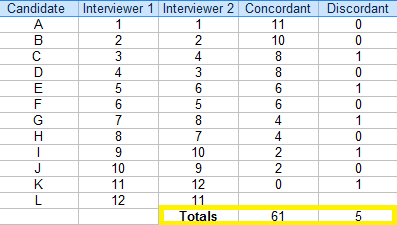
Step 5: Insert the totals into the formula:
Kendall’s Tau = (C – D / C + D)
= (61 – 5) / (61 + 5) = 56 / 66 = .85.
The Tau coefficient is .85, suggesting a strong relationship between the rankings.
Perfect Correlation
Counting how many values are below the second column seems very odd when you first do it. But it does work. Just as a thought experiment, here’s what the spreadsheet looks like if both interviewers were in perfect agreement:
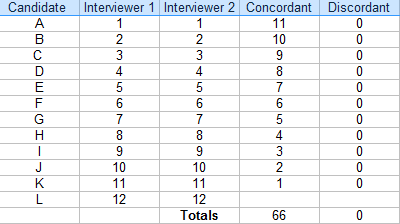
And, inserting the totals into the formula we get:
Tau = (66 – 0) / (66 + 0) = 1, which is (as we expect) perfect agreement.
Calculating Statistical Significance
If you want to calculate statistical significance for your result, use this formula to get a z-value:
![]()
Inserting the values from our results:
![]()
= 3 * .85 * 11.489 / 7.616
= 3.85.
Finding the area for a z-score of 3.85 on a z-table gives an area of .0001 — a tiny probability value which tells you this result is statistically significant.